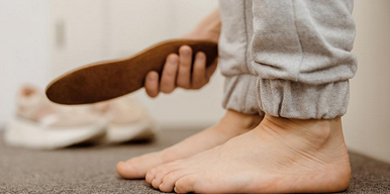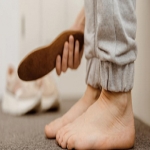Five Steps for Alleviating Flat Feet Pain

There’s a good chance you—or someone you know—have flat feet. It’s a common condition where the arches on the inside of the feet are lower than normal. While having flat feet isn’t a cause for concern, it’s important to be mindful of any pain associated from low arches. If you are among the 18 million Americans who are experiencing discomfort in your flat feet, here are some tips to keep in mind.
Evaluate Your Feet
Not sure if you have flat feet? Stand up and look at how your feet make contact with the ground. If they’re pointing outward and the soles make complete contact with the floor, you may have flat feet. This doesn’t mean you should call your orthopedic doctor right away. But you should pay attention to foot pain as it may worsen over time or lead to other ailments, including knee pain, plantar fasciitis, Achilles tendinitis, and shin splints.
The good news is most treatments are non-invasive and rarely involve surgery.
“If you are experiencing pain with flat feet, there are options that will help you feel better—and the majority do not require surgery, which we consider to be a last resort,” says Devon Nixon, MD, an orthopedic foot and ankle surgeon at the University Orthopaedic Center.
Know Your Symptoms
Common symptoms associated with flat feet include pain in the arch area and outside the ankle. If you are experiencing numbness, speak with your doctor about getting evaluated for other health conditions such as diabetes or a nerve condition.
"Pain on the inside of the foot is not uncommon in patients who are noticing changes in their foot arch,” Nixon says. “But it is reasonable to get evaluated by an orthopedic doctor at any point when it’s bothersome. If you’re feeling pain on the outside of the ankle, that could mean bones are rubbing together as the foot has flattened, so it may be a sign that the problem is progressing.”
Soothe Your Soles—and Arches
When pain is severe or interferes with your daily life, it’s time to discuss treatment options with your doctor, which may include:
- Orthotics: Although orthotics (inserts, arch supports, etc.) do not permanently correct the structure of your feet, they can provide comfort and support as you go about your daily activities.
- Physical Therapy: A physical therapist can guide you through exercises to strengthen your muscles and tendons in your feet and improve gait.
- Pain Relief Medications: Prescription or over-the-counter anti-inflammatory medicine can provide relief for painful, achy feet. Apply some Ice to cool down any swelling or inflammatory pain.

